Ah, the dreaded Toggle. Just when you think you have got it registered in your mind and all aspects covered, it rears it’s mischievous head again to trip you up ...Read through an update
Laughed at the Toggle
Was reminded of own past difficulties in that regard.

Blut und Schlacht (Blood and Battle): A Learner’s Saga
- Thread starter Bullfilter
- Start date
-
We have updated our Community Code of Conduct. Please read through the new rules for the forum that are an integral part of Paradox Interactive’s User Agreement.
You are using an out of date browser. It may not display this or other websites correctly.
You should upgrade or use an alternative browser.
You should upgrade or use an alternative browser.
Threadmarks
View all 262 threadmarks
Reader mode
Reader mode
Recent threadmarks
Chapter 159: The Valkyries’ Friend Three: Die Hard with a Vengeance (March 1021 to June 1024) Chapter 160: How do you solve a problem like Hafrid? (June 1024 to July 1026) Chapter 161: Faith, Gold and Ambition (August 1026 to June 1029) Chapter 162: War, Gold and Conquest (July 1029 – December 1031) Chapter 163: Helgi Rurikid and the Chamber of Secrets (December 1031 – October 1032) Chapter 164: Tyrs for Fears (October 1032 - September 1035) Chapter 165: A Lesson in Diplomacy (September 1035 – June 1039) Chapter 166: A Sliding Door (July 1039 – November 1041)I'm liking the speech bubbles.
I think you have the retinue mechanics down, but note that they also cost money while reinforcing. Sometimes a *lot* of money. I can't speak to which type would be best for you, as I tend to play too many Byzantium games, where Cataphracts are the good choice.
I think you have the retinue mechanics down, but note that they also cost money while reinforcing. Sometimes a *lot* of money. I can't speak to which type would be best for you, as I tend to play too many Byzantium games, where Cataphracts are the good choice.
I tend to play too many Byzantium games, where Cataphracts are the good choice.
Which, in typically understated fashion, is basically code for "Cataphracts are unstoppable mowing machines of death"
(Though I think they have been nerfed a little since the Retinue mechanic was first introduced. No more all-Cataphract legions reliably routing armies five times their size... Sigh.)
Retinues generally speaking crush raised units for whatever reason but as people have said, cost a bomb. However, it's still very easy to make more than enough money in CKII, and since you are a pagan and all your income comes from raiding, you have a very good reason to make your raiding army as large and competent as possible. Plus having an army ready at the start of a conflict is always a good dea, especially as you are going to get invaded a lot as you get bigger. Eastern Europe seems designed to not allow blobbing save for other powers coming into the region, so you have your work cut out for you.
Ch46 Q1: Retinue. Well, the recent expansion and advances have brought this option into reach. As Rurik and Helgi discuss above, I’m leaning to Housecarls – the culturally appropriate choice! Apart from advice on choices, the wiki was a little general, but I gather once you raise a retinue, that one can’t be disbanded without losing the cap invested? That is, you can’t spend the gold and cap, raise something for 600, then decide later, ‘hey, I’ll trade it in, add 300 I’ve accrued since and get the cavalry instead’? My assumption is not. Also that they’ll take a long time to get up to strength. But I’ve been wanting those HI, and the combat advantages they get look very good.
I'm not entirely sure what you mean by "losing the cap invested". You will lose all the money you have spent on that retinue when you disband it, but you free up that extra cap to use for a different retinue. It's not a currency you spend, like manpower (unless you play as a nomad), it's more like a forcelimit than anything else.
Keep in mind that all retinues have slightly higher stats than normal levies do. Housecarls get a big buff to offense, for example. The full list can be seen on the wiki.
Ah, many thanks, you have answered a large part of my question (will deal with all the retinue stuff in detail later).I'm not entirely sure what you mean by "losing the cap invested". You will lose all the money you have spent on that retinue when you disband it, but you free up that extra cap to use for a different retinue. It's not a currency you spend, like manpower (unless you play as a nomad), it's more like a forcelimit than anything else.
Keep in mind that all retinues have slightly higher stats than normal levies do. Housecarls get a big buff to offense, for example. The full list can be seen on the wiki.
Because I'm such a newbie and have never had the opportunity of a retinue before, I wasn't sure whether, once used, the cap was gone or was freed up for use again. So many other things go when used, I just didn't know and wanted to be sure (having been burned before with tribal armies).
Ah, many thanks, you have answered a large part of my question (will deal with all the retinue stuff in detail later).
Because I'm such a newbie and have never had the opportunity of a retinue before, I wasn't sure whether, once used, the cap was gone or was freed up for use again. So many other things go when used, I just didn't know and wanted to be sure (having been burned before with tribal armies).
Cap limits aren't fixed either. You can increase them massively over time. But yes, you spend your money to get to the limit, disbanding troops losses you money (or replacing deaths) but the cap limit will usually do nothing but go up over time.
Just watch out: replacing your retinue or parts of it is very costly and worth flicking the Retinue replacement button to 50% or lower when it happensAh, many thanks, you have answered a large part of my question (will deal with all the retinue stuff in detail later).
Because I'm such a newbie and have never had the opportunity of a retinue before, I wasn't sure whether, once used, the cap was gone or was freed up for use again. So many other things go when used, I just didn't know and wanted to be sure (having been burned before with tribal armies).
Military Folkmote – October 885 (a summary of advice from Chapter 46)
Military Folkmote – October 885 (a summary of advice from Chapter 46)
OK, having dealt with general comments and issues ad hoc, I’ll just summarise advice and feedback on the retinue question from the last chapter.
Ch46 Q1: Retinue. Well, the recent expansion and advances have brought this option into reach. As Rurik and Helgi discuss above, I’m leaning to Housecarls – the culturally appropriate choice! Apart from advice on choices, the wiki was a little general, but I gather once you raise a retinue, that one can’t be disbanded without losing the cap invested? That is, you can’t spend the gold and cap, raise something for 600, then decide later, ‘hey, I’ll trade it in, add 300 I’ve accrued since and get the cavalry instead’? My assumption is not. Also that they’ll take a long time to get up to strength. But I’ve been wanting those HI, and the combat advantages they get look very good.
So, my key conclusions are that the Norse HI is indeed the way to go; that it will be costly and time-consuming to raise them but worth it. And it jibes well with the Norse/Viking Russia story the Rurikids are trying to build.
This side-bar was very useful too and thanks @NeverHelm for pursuing that angle. That said, Rurik (as he foreshadowed) won’t be able to commence raising his shiny new retinue for a while yet (as I am for once still a bit behind in terms of writing up played time).
ᚔ ᚱᚢᚱᛁ ᚲᛁᛞ ᚔ
Once again, thanks everyone for the comments and pointers. Very much appreciated. The next episode shouldn’t be too long (part 2 of the last playing session, already mainly written and pictures edited).
OK, having dealt with general comments and issues ad hoc, I’ll just summarise advice and feedback on the retinue question from the last chapter.
ᚔ ᚱᚢᚱᛁ ᚲᛁᛞ ᚔ
Ch46 Q1: Retinue. Well, the recent expansion and advances have brought this option into reach. As Rurik and Helgi discuss above, I’m leaning to Housecarls – the culturally appropriate choice! Apart from advice on choices, the wiki was a little general, but I gather once you raise a retinue, that one can’t be disbanded without losing the cap invested? That is, you can’t spend the gold and cap, raise something for 600, then decide later, ‘hey, I’ll trade it in, add 300 I’ve accrued since and get the cavalry instead’? My assumption is not. Also that they’ll take a long time to get up to strength. But I’ve been wanting those HI, and the combat advantages they get look very good.
Housecarls are a sound choice -- being the Norse cultural retinue, they synergize well with the unique "Berserker Charge" battle tactic.
Again, your instincts are correct. Especially at this stage in the game, when a high income is somewhat difficult to come by regularly and reliably, you want to treat each Retinue regiment as an investment. (Also keep in mind that when you build one, it starts out "empty" and takes time to reinforce.)
About the question, no you can’t trade them in for the upgraded model as far as I know. On the other hand, I think the HI is much better value for money. For the best battle events involving HC, it should be at least 10% of the wing it is on (and preferably much more). That 50HC 200LC brigade is too diluted for my taste, even if that was cheaper I’d probably go for the HI, and when I have more gold and cap maybe another one of HI. Are there other choices of HC that’s not as diluted?
Re the retinue deffo get the HI 1st. Will take you ages to be in a position to get cavalry and professionals are mint warriors.
I think you have the retinue mechanics down, but note that they also cost money while reinforcing. Sometimes a *lot* of money. I can't speak to which type would be best for you, as I tend to play too many Byzantium games, where Cataphracts are the good choice.
Retinues generally speaking crush raised units for whatever reason but as people have said, cost a bomb. However, it's still very easy to make more than enough money in CKII, and since you are a pagan and all your income comes from raiding, you have a very good reason to make your raiding army as large and competent as possible. Plus having an army ready at the start of a conflict is always a good dea, especially as you are going to get invaded a lot as you get bigger. Eastern Europe seems designed to not allow blobbing save for other powers coming into the region, so you have your work cut out for you.
So, my key conclusions are that the Norse HI is indeed the way to go; that it will be costly and time-consuming to raise them but worth it. And it jibes well with the Norse/Viking Russia story the Rurikids are trying to build.
I'm not entirely sure what you mean by "losing the cap invested". You will lose all the money you have spent on that retinue when you disband it, but you free up that extra cap to use for a different retinue. It's not a currency you spend, like manpower (unless you play as a nomad), it's more like a forcelimit than anything else.
Keep in mind that all retinues have slightly higher stats than normal levies do. Housecarls get a big buff to offense, for example. The full list can be seen on the wiki.
Ah, many thanks, you have answered a large part of my question (will deal with all the retinue stuff in detail later).Because I'm such a newbie and have never had the opportunity of a retinue before, I wasn't sure whether, once used, the cap was gone or was freed up for use again. So many other things go when used, I just didn't know and wanted to be sure (having been burned before with tribal armies).
Cap limits aren't fixed either. You can increase them massively over time. But yes, you spend your money to get to the limit, disbanding troops losses you money (or replacing deaths) but the cap limit will usually do nothing but go up over time.
Just watch out: replacing your retinue or parts of it is very costly and worth flicking the Retinue replacement button to 50% or lower when it happens
ᚔ ᚱᚢᚱᛁ ᚲᛁᛞ ᚔ
Once again, thanks everyone for the comments and pointers. Very much appreciated. The next episode shouldn’t be too long (part 2 of the last playing session, already mainly written and pictures edited).
Chapter 47: The Crow Calls (1 November 885 – 25 March 886)
Chapter 47: The Crow Calls (1 November 885 – 25 March 886)
Previously, on Blut und Schlacht … One set of peasant troublemakers has been vanquished, but another revolt eruptedin Vladimir before the blood has even dried on the snows of Zaozerye and the heads still decorate stakes on the palisade of Chud's wooden walls. Rurik's army will soon take his stern justice to the remaining rebels; but first his commanders and vassal allies must gather themselves in the one place. A task that is proving a little more difficult than anticipated.
November-December 885
In early November, the pieces on the board were falling slowly into place. The Vladimiran levy still followed the main army at a distance. And the Smolenskians were on the march, but towards Toropets, rather than Vyazma. But not to worry, it was just a short hop from there to Tver, where Þorsteinn’s army was now heading. The garrison in Pereyslavl Zalessky was large and should be able to hold out for quite a while.
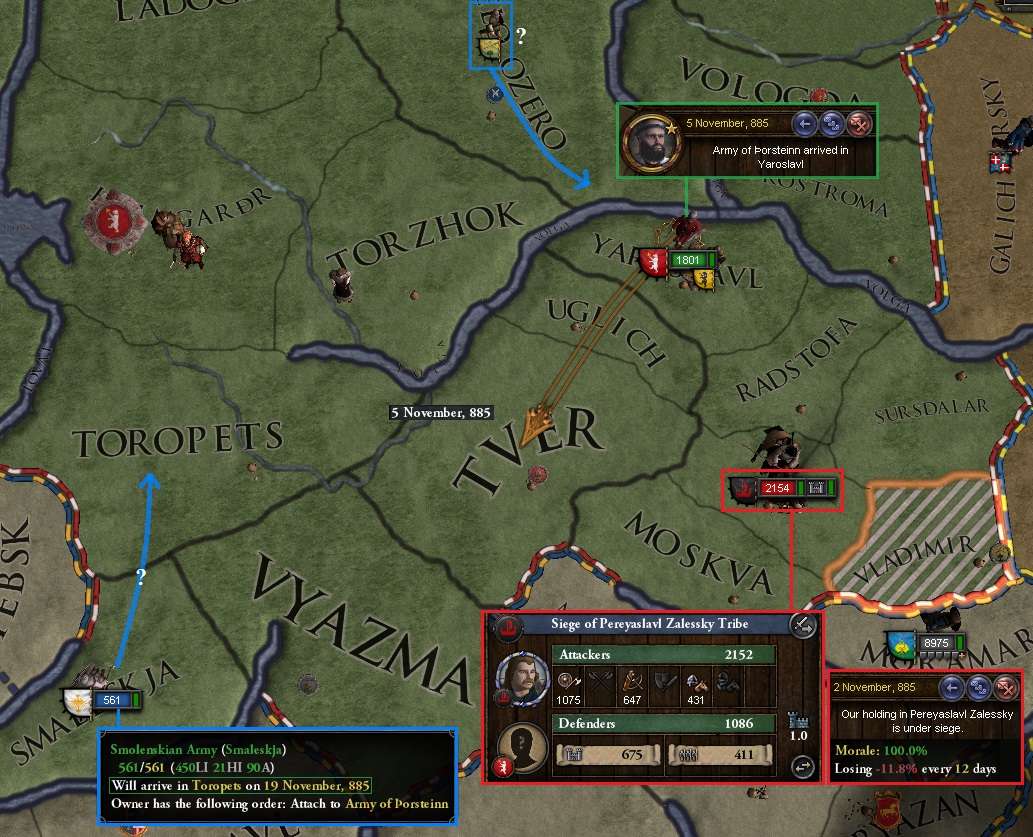
As King Rurik was hearing a dispute between two Holmgarðian farmers – over who owned which parcel of land – there was a small commotion at the entrance to the meeting hall where he was holding court. An unfamiliar Godi stood there – very unfamiliar, as he was not sporting a beard and did not look exactly the same as every other Godi Rurik had encountered in the entire time he had ruled the realm. He quickly adjudicated the dispute – one of the farmers was clearly a devious trickster and had put up a frivolous claim – and beckoned the Godi forward.
The man clearly wanted the job, Rurik wrote later in his personal journal. But I had other ideas – there was someone more senior and far better qualified for the job I had wanted to appoint for some time. Even if I’m not too sure about him personally, he’s the best for the job.
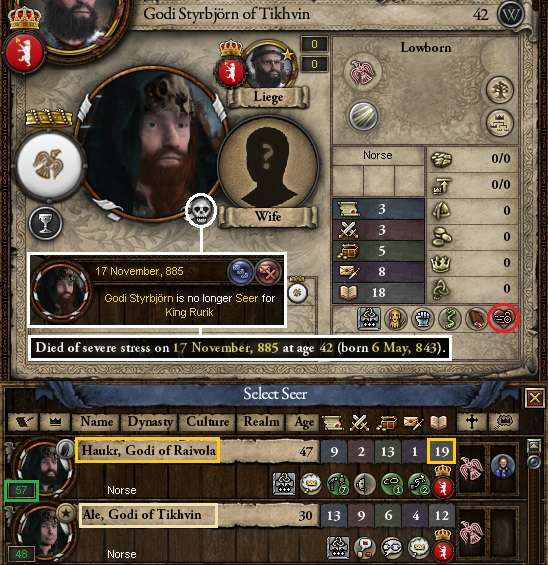
Rurik immediately sent word to Godi Haukr of Raivola to invite him to join the Council as the new Seer. At least he looks like a Godi should, noted Rurik.

The same day, as the Vladimir levy – being led by a commander named Toste - began to head from Yaroslavl (where the local levy had been raised but was seemingly not going anywhere) to their home county, Rurik decided to formally issue the call to arms to Hrolfr as well [basically, just to see what would happen and hope they would turn right and join the rest in Tver].
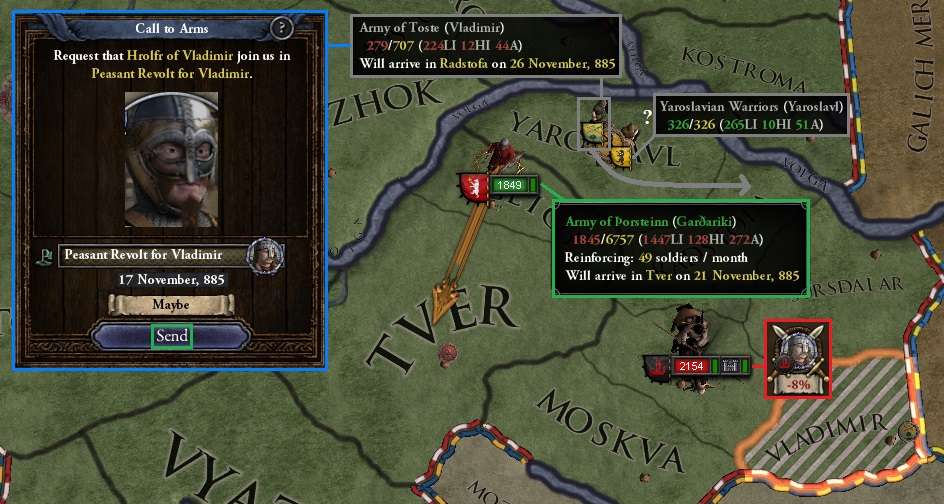
On 24 November, word came back: of course Hrolfr would join the war to liberate his own county from rebel control. But rather than join the main army straight away (as ordered), Toste decided he would head to Vladimir first – much good it would do him! Meanwhile, the Smolenskians kept heading north-east to Torzhok instead of swinging around to join Þorsteinn, who by 21 November had arrived in Tver, the rallying point for the attack on the rebels. What!?
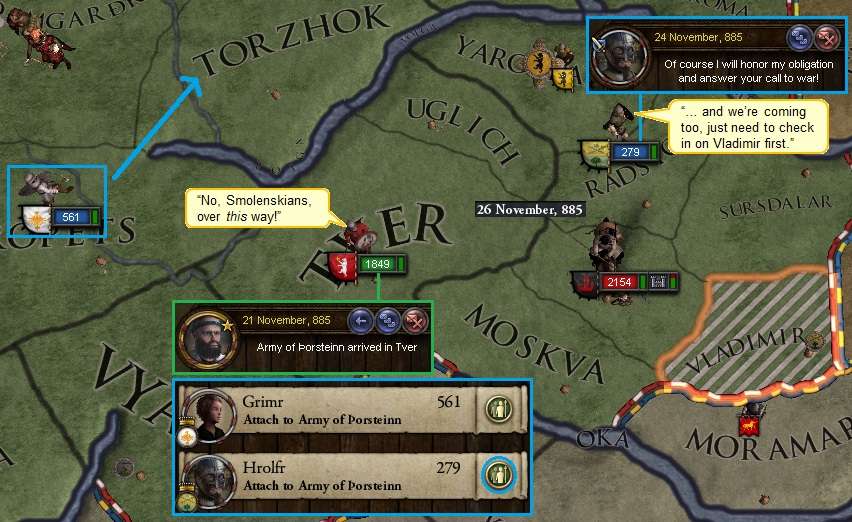
The farcical wanderings of the vassal levies only got worse as winter wore on. By mid-December the Smolenskians were still headed north-east, from Torzhok to Belo Ozero, while Toste kept heading towards Vladimir.
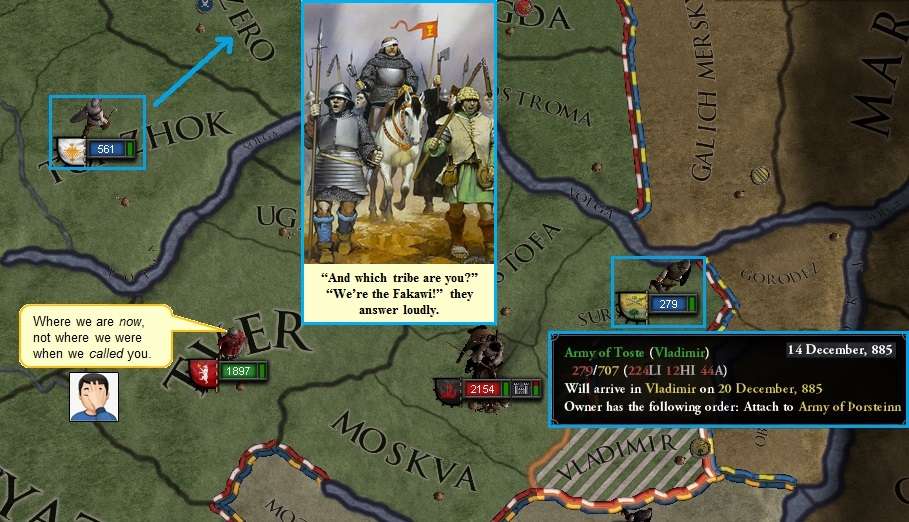
January-February 886
As Setyamka’s siege of Pereyslavl Zalessky wore on due the dilatory amblings of Rurik’s allied vassals, new recruits trickled into Þorsteinn’s command, the Smolenskians turned around and starting heading in the right direction and Toste’s detachment had almost completed its circumnavigation of the rebels and was heading from Moskva to Tver.

By January’s end, the Vladimirans had arrived in Tver, the Smolenskians were due by 7 February – and Setyamka had almost reduced Pereyslavl Zalessky, which would now fall due to the tardiness of the vassal companies. Meanwhile, a major battle between Konugarðr and Mari was taking place just over the border from Vladimir. And Dyre was badly outnumbered.

Pereyslavl Zalessky fell on 6 February and the bold Setyamka immediately advanced on Tver, leaving behind 51 casualties and a garrison of 66. He kept on towards Tver despite the arrival of the Smolenskians the next day – so Þorsteinn simply waited in place as the rebel marched to his own execution – or so Þorsteinn hoped. He would have another three weeks to prepare his defences.
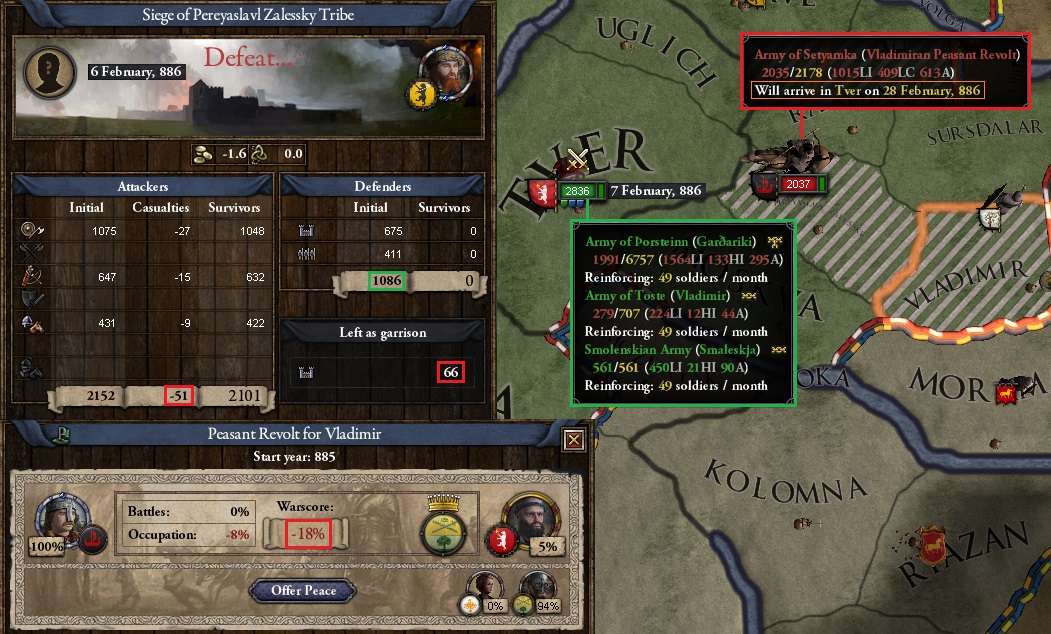
At this time, Rurik received his Chancellor’s report on the Konugarðr-Mari war they had observed from a distance. It seemed much had changed in the few years since Rurik last paid close attention to his southern neighbour and fellow Norseman. But no longer co-religionist! Dyre had converted to Orthodox Christianity (apostate swine, forsaking the True Germanic Faith and Gods, Odin curse him) and declared a Holy War on Mari’s High Chief Saksa ‘the Monster’. Who had a few years back subjugated the Mordvin realm that was left after Rurik and the Cumans had sliced chunks off for themselves.
Saksa was winning that war – and the battle currently in progress, where Dyre’s forces were now in full retreat and being pursued. One Chief Purginepaz had managed to assemble an army of (as it currently stood) 7,500 men by himself, including a force of over 1,000 heavy infantry! Surely a tribal or holy army of some sort. Rurik hoped they would disband after the conflict was over – that was a truly substantial force for these parts. Dyre would not be able to withstand them. Especially having now been soundly thrashed, with little money and a poor reputation. Though much piety in the eyes of his new false religion.
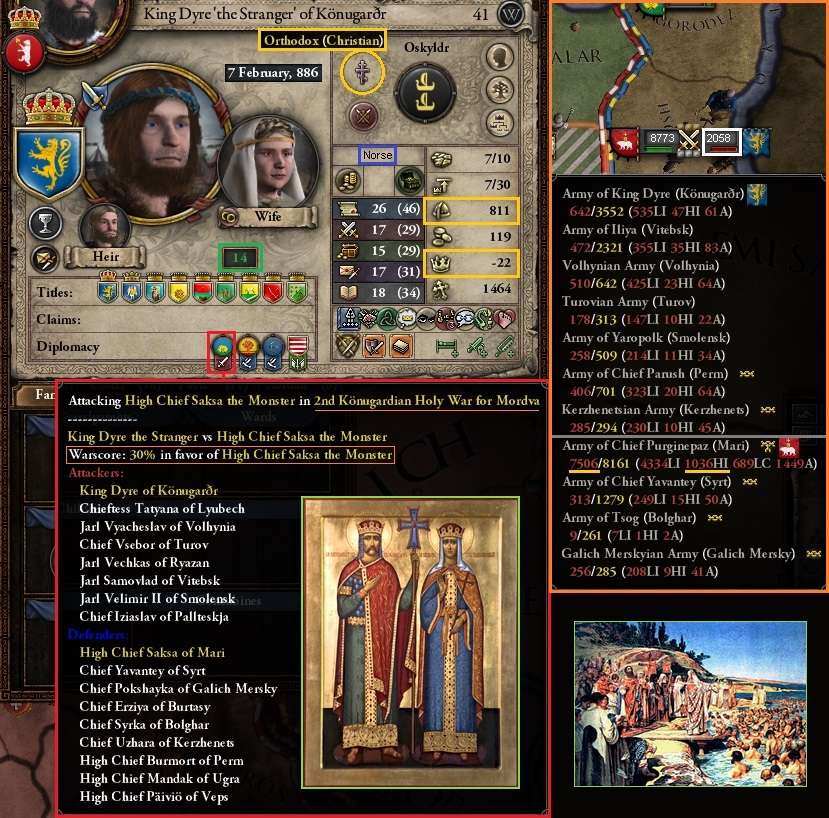
The Battle of Tver began on 28 February 886, as Setyamka’s rebel host – with superiority in archers and cavalry, but nothing else – boldly attacked Þorsteinn’s Garðarikian host.
[For narrative purposes, we will for one imagine this battle took place in a day, though of course it stretched over a number in game terms. I used the opportunity to drill down a little further than I had in the past into tactics and damage factors – and in doing so, learned a little bit more. Any who care to add general or specific clarifications are very welcome to do so at the Þing!]
The attackers were evenly distributed across all three sectors. Þorsteinn’s central division was, as was usual by then, very strong with weaker screening flanks. This was in part due to the [by now entrenched and repeated in every battle I’ve looked for it] deployment of both the vassal allied regiments in the centre, over which Þorsteinn [ie. me] had no control. Added to the main Holmgarðr Tribe’s company, this made a very large body of troops, while the flanks (made up of many smaller detachments) were left relatively undermanned [something I may try to adjust for in the future, now that I know that’s the way the vassals are going to keep deploying].
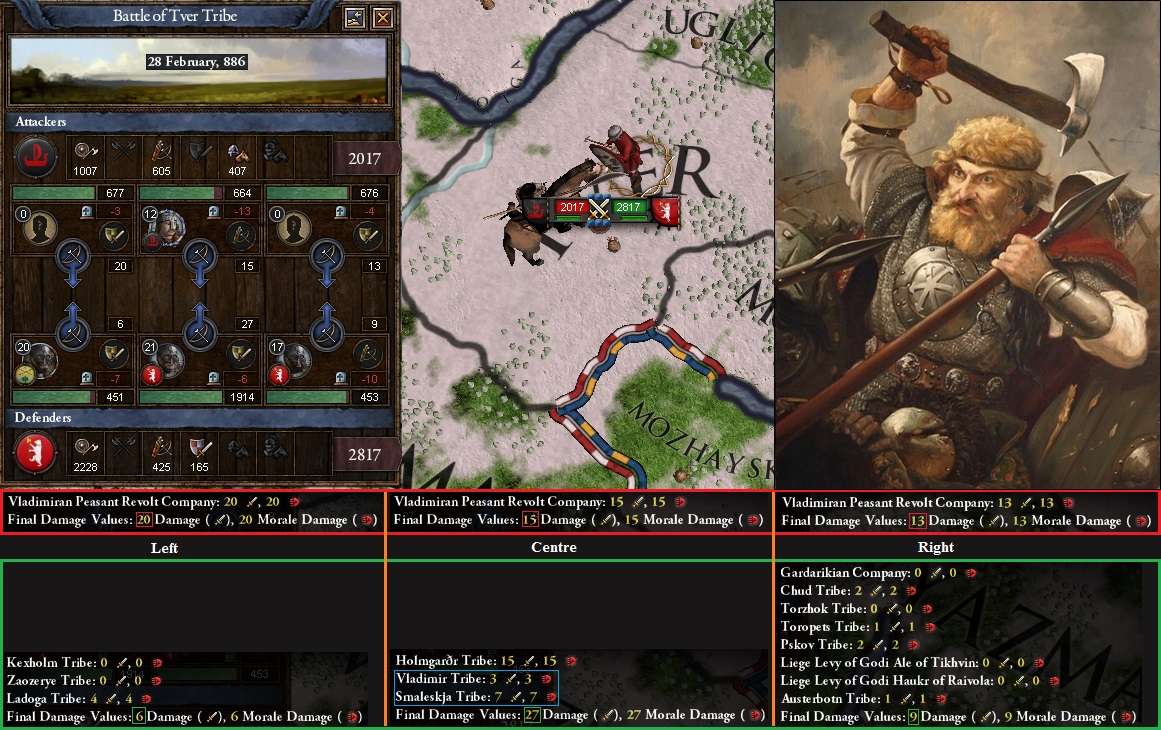
Þorsteinn, axe swinging, is pictured (right) in the front line during the Battle of Tver. His reputation as a berserk warrior would be greatly enhanced during this battle.
This meant the two flanks of Hrolfr and Sverker (especially the former, despite his flanking skills) would be out-muscled, but the central division should heavily overpower its opponent – in this case, Setyamka, the rebel commander (and their only battlefield leader).
March 886
Setyamka’s regiment could not withstand the massed might of the Holmgarðr, Smaleskja and Vladimir levies – the latter fighting for their home county with particular ferocity and no mercy. The snow soon ran red with the blood of the rebels – they turned tail and ran (8 March). Would Þorsteinn continue to pursue or rally his troops to try to save Hrolfr?

After a short pursuit, Þorsteinn looked to his left and, through the red fog of battle, saw his friend, Chief Hrolfr, had been broken, with the rebels in hot pursuit (11 March).
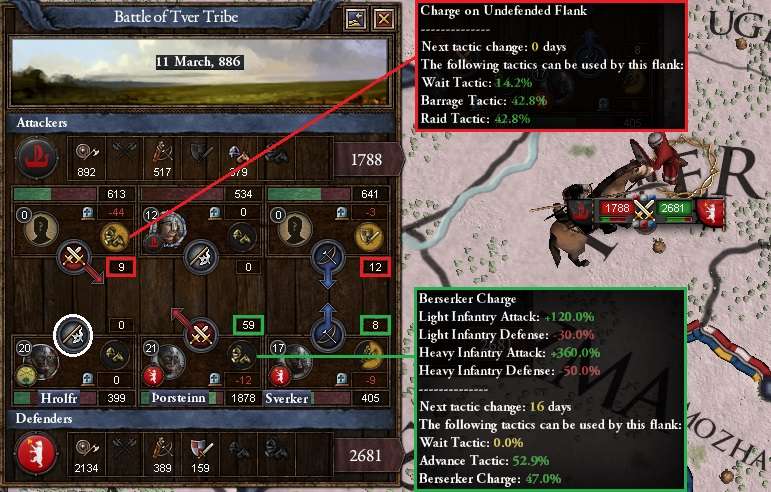
The berserk charge crushed the enemy right flank very quickly and the rebels headed for the relative safety of the woods after taking heavy casualties (12 March). Letting them go for now, Þorsteinn turned his attentions onto the enemy's surviving left wing, resting his exhausted infantry and instead directing withering archery volleys onto the remaining rebels, who up to that point had been gaining the upper hand on Sverker’s outnumbered right flank. They resisted longer than their rebel compatriots but were also ultimately broken. By the evening (16 March), the field was Þorsteinn’s and the miserable surviving rebels were pursued through the winter snows.
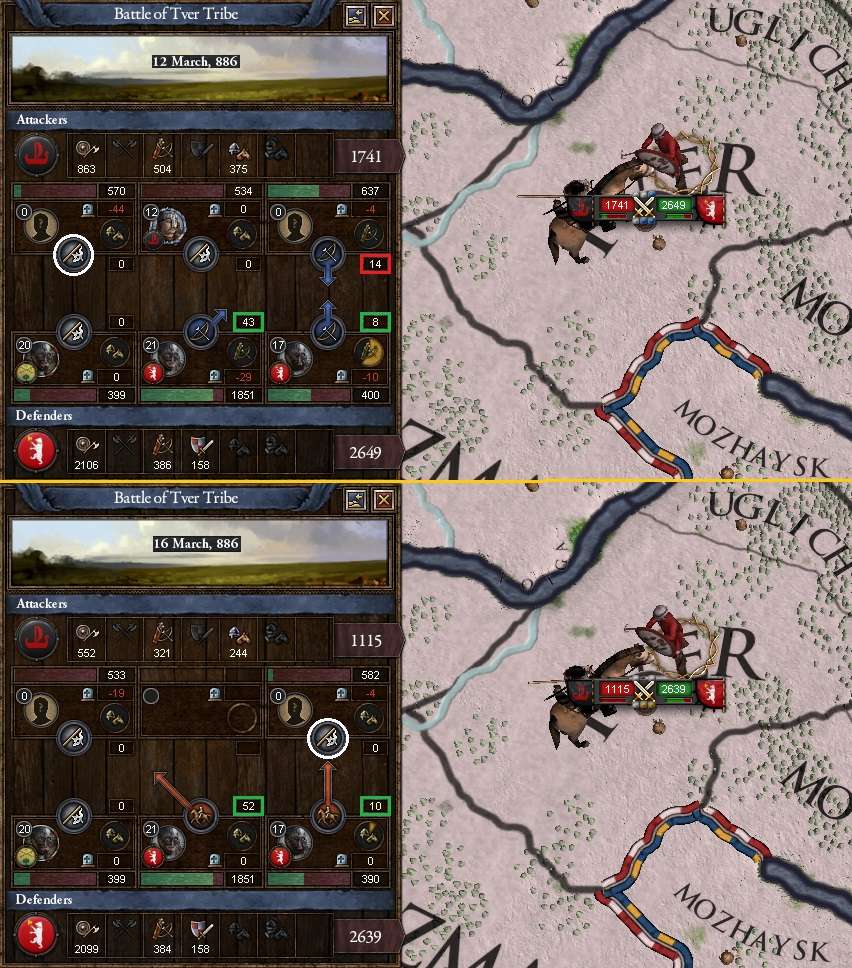
On 25 March, after nine days of pursuit, a bedraggled emissary from the rebels was brought before Þorsteinn.
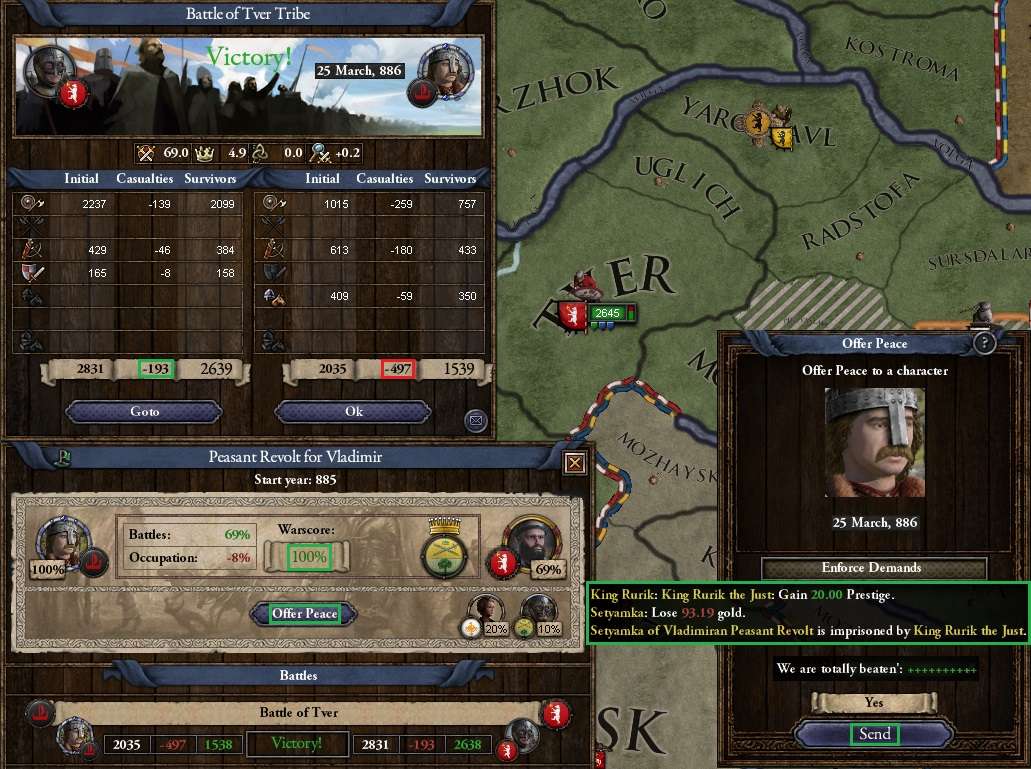
Setyamka was soon in chains and the revolt ended.
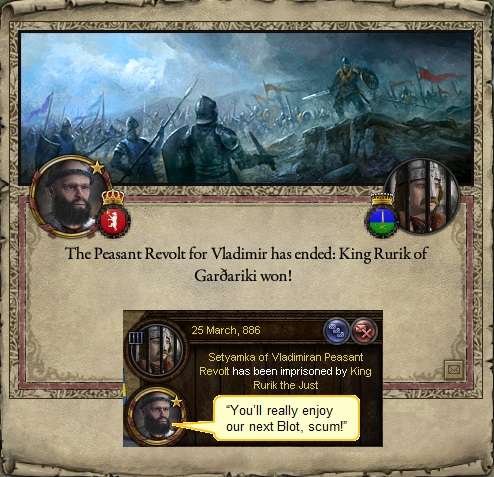
Questions and Notes
Ch47 Q1: Vassal Ally Wanderlust #1. So, my working hypothesis here is that Grimr’s men are (for some arcane reason) heading towards where the army was when they were summoned rather than where they are now. I even tried detaching and reattaching them when they lobbed into Torzhok and were shown still heading away, but to no avail. Perhaps the orders were lost in the winter snows?
Ch46 Q2: Vassal Ally Wanderlust #2. As for the Vladimiran levy, my theory there is that they had been unable to disperse and return home at the end of the first rebel war, because Vladimir had already fallen by then. So they started heading home – logical enough. Then they kept going even after answering the call and being ordered to join the nearby main army in Tver. Some kind of compulsion again, or the AI being unable to cope with new orders at that point? You will see both situations resolved themselves eventually and that may shed some light on the answers, but I’d be curious to know if there’s some discernible mechanic working here, so I’ll be better informed next time. This dragged things out, as I didn’t feel I had the numbers to attack confidently without both of them.
Author’s Postscript: In terms of gameplay, this session went on a bit longer, as another (quite separate) event coincidentally arose on 25 March (the last day of the rebel war), which led directly on to issues of politics, factions, intrigue and possible marriage arrangements. But again, this chapter was already long enough and the end of the second peasant revolt seemed a good place to end it. The coming events will spawn a range of questions for the Þing: this one was perhaps a little simpler, so not as many specific questions arising. But, as always, any general comments, unsolicited advice on things you see or narrative discussion is also very welcome.
The crows of southern Garðaríki have been well fed of late. Both Valdimiran rebels and - just over the border - the levies of Dyre ‘the Stranger’ (more like Dyre ‘the Apostate False-God Idolator’) have helped fatten them for the coming spring.
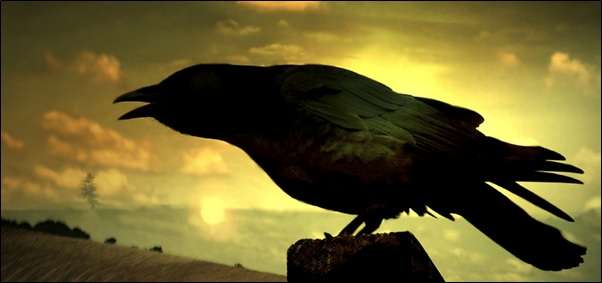
“Ask not for whom the crow calls, Setyamka. It crows for thee!”
Previously, on Blut und Schlacht … One set of peasant troublemakers has been vanquished, but another revolt eruptedin Vladimir before the blood has even dried on the snows of Zaozerye and the heads still decorate stakes on the palisade of Chud's wooden walls. Rurik's army will soon take his stern justice to the remaining rebels; but first his commanders and vassal allies must gather themselves in the one place. A task that is proving a little more difficult than anticipated.
ᚔ ᚱᚢᚱᛁ ᚲᛁᛞ ᚔ
November-December 885
In early November, the pieces on the board were falling slowly into place. The Vladimiran levy still followed the main army at a distance. And the Smolenskians were on the march, but towards Toropets, rather than Vyazma. But not to worry, it was just a short hop from there to Tver, where Þorsteinn’s army was now heading. The garrison in Pereyslavl Zalessky was large and should be able to hold out for quite a while.

“Sad news, King Rurik,” said the man. “My name is Ale and I have the honour to be your new Godi of Tikhvin. The Seer, Godi Styrbjörn, died this afternoon. He just keeled over while performing a ritual. He had been complaining of the stress of his roles of late. And it seems the Gods have summoned him to Folkwang(1). I have been appointed as Godi in his place, but the position of Seer for the realm is now vacant and within your gift, oh wise and noble King.”
Thanks to @TheButterflyComposer for quite rightly pointing out Valhalla was not appropriate for a priest to go to and to @GulMacet for suggesting Folkwang as a better destination for the deceased Godi and Seer of the realm. 

The man clearly wanted the job, Rurik wrote later in his personal journal. But I had other ideas – there was someone more senior and far better qualified for the job I had wanted to appoint for some time. Even if I’m not too sure about him personally, he’s the best for the job.

“Thank you, Ale, we will send poor Styrbjörn off in style tonight. I’m sure you will now be very busy organising things – but be careful you don’t get too stressed about it!”
Rurik immediately sent word to Godi Haukr of Raivola to invite him to join the Council as the new Seer. At least he looks like a Godi should, noted Rurik.




Ch46 Q1: Vassal Ally Wanderlust #1. So, my working hypothesis here is that Grimr’s men are (for some arcane reason) heading towards where the army was when they were summoned rather than where they are now. I even tried detaching and reattaching them when they lobbed into Torzhok and were shown still heading away, but to no avail. Perhaps the orders were lost in the winter snows?
Ch46 Q2: Vassal Ally Wanderlust #2. As for the Vladimiran levy, my theory there is that they had been unable to disperse and return home at the end of the first rebel war, because Vladimir had already fallen by then. So they started heading home – logical enough. Then they kept going even after answering the call and being ordered to join the nearby main army in Tver. Some kind of compulsion again, or the AI being unable to cope with new orders at that point? You will see both situations resolved themselves eventually and that may shed some light on the answers, but I’d be curious to know if there’s some discernible mechanic working here, so I’ll be better informed next time. This dragged things out, as I didn’t feel I had the numbers to attack confidently without both of them.
ᚔ ᚱᚢᚱᛁ ᚲᛁᛞ ᚔ
January-February 886
As Setyamka’s siege of Pereyslavl Zalessky wore on due the dilatory amblings of Rurik’s allied vassals, new recruits trickled into Þorsteinn’s command, the Smolenskians turned around and starting heading in the right direction and Toste’s detachment had almost completed its circumnavigation of the rebels and was heading from Moskva to Tver.



Saksa was winning that war – and the battle currently in progress, where Dyre’s forces were now in full retreat and being pursued. One Chief Purginepaz had managed to assemble an army of (as it currently stood) 7,500 men by himself, including a force of over 1,000 heavy infantry! Surely a tribal or holy army of some sort. Rurik hoped they would disband after the conflict was over – that was a truly substantial force for these parts. Dyre would not be able to withstand them. Especially having now been soundly thrashed, with little money and a poor reputation. Though much piety in the eyes of his new false religion.

[For narrative purposes, we will for one imagine this battle took place in a day, though of course it stretched over a number in game terms. I used the opportunity to drill down a little further than I had in the past into tactics and damage factors – and in doing so, learned a little bit more. Any who care to add general or specific clarifications are very welcome to do so at the Þing!]
The attackers were evenly distributed across all three sectors. Þorsteinn’s central division was, as was usual by then, very strong with weaker screening flanks. This was in part due to the [by now entrenched and repeated in every battle I’ve looked for it] deployment of both the vassal allied regiments in the centre, over which Þorsteinn [ie. me] had no control. Added to the main Holmgarðr Tribe’s company, this made a very large body of troops, while the flanks (made up of many smaller detachments) were left relatively undermanned [something I may try to adjust for in the future, now that I know that’s the way the vassals are going to keep deploying].

Þorsteinn, axe swinging, is pictured (right) in the front line during the Battle of Tver. His reputation as a berserk warrior would be greatly enhanced during this battle.
This meant the two flanks of Hrolfr and Sverker (especially the former, despite his flanking skills) would be out-muscled, but the central division should heavily overpower its opponent – in this case, Setyamka, the rebel commander (and their only battlefield leader).
ᚔ ᚱᚢᚱᛁ ᚲᛁᛞ ᚔ
March 886
“Sir, their central division is backpedalling!”
“Sound the horn for the charge – we must break them quickly!” Hrolfr’s left flank was itself buckling looked like it would soon break itself. “With me! Have at them men – send them all to Hel, the filthy curs!”
“Sound the horn for the charge – we must break them quickly!” Hrolfr’s left flank was itself buckling looked like it would soon break itself. “With me! Have at them men – send them all to Hel, the filthy curs!”
Setyamka’s regiment could not withstand the massed might of the Holmgarðr, Smaleskja and Vladimir levies – the latter fighting for their home county with particular ferocity and no mercy. The snow soon ran red with the blood of the rebels – they turned tail and ran (8 March). Would Þorsteinn continue to pursue or rally his troops to try to save Hrolfr?

“Halt! Rally the men. Sound the horns – send the signal to reform to the left.” This is done so quickly. A short look to the right sees Sverker still hard press but holding his own. He would have to do so a while longer.
After a few minutes, the central division was reformed – the glory of blood and battle sang in their ears and tinged their eyesight red.
Þorsteinn, the blood rage on him, yelled out in a stentorian voice: “For Rurik! I’ll see all you whoresons at the victory feast or Valhalla by evening’s fall. Attack!”
Þorsteinn, the blood rage on him, yelled out in a stentorian voice: “For Rurik! I’ll see all you whoresons at the victory feast or Valhalla by evening’s fall. Attack!”
With a bloodcurdling, primal war-cry, the whole host – over 1,800 warriors, already covered in the their own and their enemies’ blood, make a berserk charge on the rebels right wing, who were still pursuing Hrolfr’s division. They were oblivious to their fate until it was too late – Þorsteinn’s men crashed into their flank in a great rending of armour, flesh and bone. The carnage was severe.


“Our leader Setyamka acknowledges we are totally beaten. The battle is over, and the war. He asks for your terms.”
Þorsteinn turned to Hrolfr and nodded to him with understated but genuine deference. “Chief Hrolfr, you are the ranking lord here and Chief of Vladimir. I think it only right that you dictate the terms.”
Hrolfr maintained his temper – after all, he must try to rule the county that has just revolted against him in his absence. “Tell Setyamka my terms are simple and merciful. For most. Any remaining rebels are pardoned if they will lay down their arms and return peacefully to their farms and villages. Setyamka is to deliver himself, bringing with him reparations consisting of all the money he has extorted or looted during his rebellion. He will be imprisoned at the pleasure of King Rurik – the Just.” He can’t help thinking to himself that while Rurik is just, he is not soft. Setyamka’s lot will not be an easy one.
Þorsteinn turned to Hrolfr and nodded to him with understated but genuine deference. “Chief Hrolfr, you are the ranking lord here and Chief of Vladimir. I think it only right that you dictate the terms.”
Hrolfr maintained his temper – after all, he must try to rule the county that has just revolted against him in his absence. “Tell Setyamka my terms are simple and merciful. For most. Any remaining rebels are pardoned if they will lay down their arms and return peacefully to their farms and villages. Setyamka is to deliver himself, bringing with him reparations consisting of all the money he has extorted or looted during his rebellion. He will be imprisoned at the pleasure of King Rurik – the Just.” He can’t help thinking to himself that while Rurik is just, he is not soft. Setyamka’s lot will not be an easy one.


ᚔ ᚱᚢᚱᛁ ᚲᛁᛞ ᚔ
Questions and Notes
Ch47 Q1: Vassal Ally Wanderlust #1. So, my working hypothesis here is that Grimr’s men are (for some arcane reason) heading towards where the army was when they were summoned rather than where they are now. I even tried detaching and reattaching them when they lobbed into Torzhok and were shown still heading away, but to no avail. Perhaps the orders were lost in the winter snows?
Ch46 Q2: Vassal Ally Wanderlust #2. As for the Vladimiran levy, my theory there is that they had been unable to disperse and return home at the end of the first rebel war, because Vladimir had already fallen by then. So they started heading home – logical enough. Then they kept going even after answering the call and being ordered to join the nearby main army in Tver. Some kind of compulsion again, or the AI being unable to cope with new orders at that point? You will see both situations resolved themselves eventually and that may shed some light on the answers, but I’d be curious to know if there’s some discernible mechanic working here, so I’ll be better informed next time. This dragged things out, as I didn’t feel I had the numbers to attack confidently without both of them.
ᚔ ᚱᚢᚱᛁ ᚲᛁᛞ ᚔ
Author’s Postscript: In terms of gameplay, this session went on a bit longer, as another (quite separate) event coincidentally arose on 25 March (the last day of the rebel war), which led directly on to issues of politics, factions, intrigue and possible marriage arrangements. But again, this chapter was already long enough and the end of the second peasant revolt seemed a good place to end it. The coming events will spawn a range of questions for the Þing: this one was perhaps a little simpler, so not as many specific questions arising. But, as always, any general comments, unsolicited advice on things you see or narrative discussion is also very welcome.
ᚔ ᚱᚢᚱᛁ ᚲᛁᛞ ᚔ
The crows of southern Garðaríki have been well fed of late. Both Valdimiran rebels and - just over the border - the levies of Dyre ‘the Stranger’ (more like Dyre ‘the Apostate False-God Idolator’) have helped fatten them for the coming spring.

“Ask not for whom the crow calls, Setyamka. It crows for thee!”
Last edited:
And it seems the Gods have summoned him to Valhalla.
Point of order: he can't get into Valhalla. It is a hall just for the valorious (geddit?) Who died in battle. Odins secret army of badass normals for Ragnarok. The priest is 'doomed' to Hel I think, unless, as you re-establish the religion, you want to change that? It's not an awful place for the rightous, just not as awesome for vikings as valhalla. But not bad at all.
Ch46 Q1: Vassal Ally Wanderlust #1. So, my working hypothesis here is that Grimr’s men are (for some arcane reason) heading towards where the army was when they were summoned rather than where they are now. I even tried detaching and reattaching them when they lobbed into Torzhok and were shown still heading away, but to no avail. Perhaps the orders were lost in the winter snows?
Yeah, so here'a how Paradox seems to have figured this. You summon your levies and they move to a centre point to form a combined army, which tends to be either the middle of the country or wherever your main kings army is. Because CKII players are twitcy people condtantly movong and redeciding where their armies go, P seems to have made the AI allies a bit slower to change directions. They'll keep going to where they were going unless you get into a big battle (hopefully, dont count in this!) Or merge with them and take command.
So its usually good to either meet up with them early and take over movement or wait for a bit for everyone to come to you before moving out. Whichever is better for the war you are currently fighting.
Fair cop - added the Valhalla line in at the last minute without checking - shoulda known!Point of order: he can't get into Valhalla. It is a hall just for the valorious (geddit?) Who died in battle. Odins secret army of badass normals for Ragnarok. The priest is 'doomed' to Hel I think, unless, as you re-establish the religion, you want to change that? It's not an awful place for the rightous, just not as awesome for vikings as valhalla. But not bad at all.
Yeah, so here'a how Paradox seems to have figured this. You summon your levies and they move to a centre point to form a combined army, which tends to be either the middle of the country or wherever your main kings army is. Because CKII players are twitcy people condtantly movong and redeciding where their armies go, P seems to have made the AI allies a bit slower to change directions. They'll keep going to where they were going unless you get into a big battle (hopefully, dont count in this!) Or merge with them and take command.
So its usually good to either meet up with them early and take over movement or wait for a bit for everyone to come to you before moving out. Whichever is better for the war you are currently fighting.
Thanks re the Allies rallying.
Al-lies? What are al-lies?
Fair cop - added the Valhalla line in at the last minute without checking - shoulda known!
Thanks re the Allies rallying.
?
A better descritipn of AI allies really. The game really does lie about their numbers, effectiveness and how much they'll, y'know, help you.
Fair cop - added the Valhalla line in at the last minute without checking - shoulda known!
Actually, Valhalla is only for those fallen in battle, but good people who died a peaceful death don't go to Hel, they go to Folkwang (Hall of the People) to enjoy the Afterlife with Freyja!
Actually, Valhalla is only for those fallen in battle, but good people who died a peaceful death don't go to Hel, they go to Folkwang (Hall of the People) to enjoy the Afterlife with Freyja!
It varies/depends on the person at the time (some held quite negative views of any male death not in battle). Like i said, depends on how he wants to write it since he's going to reform the religion at some point anyway and much of what we have on the myths were written much later by christian influenced writers.
May he smell Loki’s bellybutton in HelDyre had converted to Orthodox Christianity
VUR HA!!“For Rurik! I’ll see all you whoresons at the victory feast or Valhalla by evening’s fall. Attack!”
Excellent example showing the importance of battle tactics. Note that the tactic wouldn’t been chosen if there weren’t heavy infantry present.The berserk charge crushed the enemy right flank very quickly
4 letters: BLOTHe will be imprisoned at the pleasure of King Rurik – the Just.”
About the rallying problem, well I didn’t know it was possible to merge with ally armies before this AAR, so no idea. But, after that many patches and DLCs etc one expects this kind of bugs to be smoothed out.
I hope the following events were good for us. Infidel King of Konugarthr died in battle?
I’ll edit when I get the chance, thanks!Actually, Valhalla is only for those fallen in battle, but good people who died a peaceful death don't go to Hel, they go to Folkwang (Hall of the People) to enjoy the Afterlife with Freyja!
I do like the sound of Folkwang though.It varies/depends on the person at the time (some held quite negative views of any male death not in battle). Like i said, depends on how he wants to write it since he's going to reform the religion at some point anyway and much of what we have on the myths were written much later by christian influenced writers.
Threadmarks
View all 262 threadmarks
Reader mode
Reader mode

